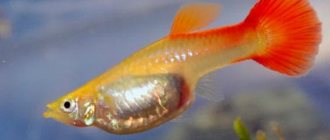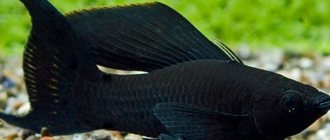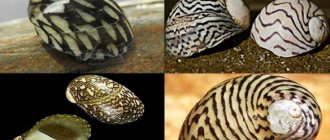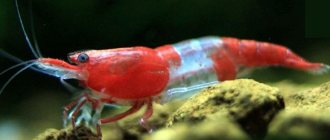Mollies are a popular aquarium fish, distinguished by their richly colored scales and easy-going nature. Many aquarists keep the phenotype both in a separate and in a species tank, and of course, they breed mollies. Before embarking on such a responsible task, you should know how aquarium fish reproduce, how mollies directly give birth, and how to raise mollies fry at home.
General characteristics of the species
Mollies are aquarium fish from the genus Poeciliidae, belonging to the order Cyprinodontiformes. The main feature of the phenotype is that molly is a viviparous fish, and is capable of bearing and giving birth to offspring that are completely ready for independent life immediately after birth. In the wild, molly fish look modest and inconspicuous, but in pet stores, thanks to the painstaking work of breeders, you can see many different ornamental fish species that differ in color and body shape. The color of molly scales varies from jet black to white and orange, and the body shape can be disc or balloon.
Interesting fact: only this species can have a “balloon” body shape. In balloon mollies, reproduction occurs in the same way as in other relatives.
Mollies diseases: signs, causes, treatment
The sad fact is that Mollies are susceptible to a number of diseases. In most cases, improper care. If you promptly identify the initial signs of inflammatory processes, you can save the life of the fish. Let's take a closer look at the most common of them:
Non-communicable diseases Mollies
- Hypothermia or strong heating of aquarium water. Too high a temperature leads to premature aging of living organisms. Low temperatures provoke the appearance of diseases and even death. Monitor the temperature with a thermometer, which should be in the aquarium;
- Oxygen deficiency. If you notice that fish are greedily gasping for air and swimming only on the surface, immediately buy a more powerful compressor. Otherwise, the molly experiences infertility, suffocation, loss of appetite, and soon they die;
- Chlorine poisoning. An excess of chloride compounds will not benefit Mollies: it is difficult for them to breathe, the color is lighter, restlessness in behavior appears, and there is no reaction. Death comes very quickly. Therefore, regularly monitor chlorine levels;
- Alkali disease. There is a decrease in activity, timidity in all fish, mucus appears on the gills, and the color becomes lighter. You should monitor the level of alkali in the water and avoid changes;
- Obesity. Regular overfeeding threatens to kill the fish. Prevention is a combination of different types of feed in small doses and 2 times a day;
- Gas embolism. Develops when there is an excess of oxygen. The gills of the fish darken and their behavior is extremely restless. Occurs when a large volume of untreated tap water is poured into the aquarium. To improve the condition of Mollies, it is necessary to replace the water with 30% settled water.
Contagious diseases Mollies
- Hexamitosis. Lumps and pits appear on the head. If the outcome is positive, recovered individuals will have traces and scars. For treatment, you should heat the water to +35° C or add metronidazole to the water;
- Fin rot. The fish's fins are deformed, the abdomen may be slightly swollen, and there are ulcers. The infected individual is separated from others, the water is treated with a solution of levomethicin;
- White-skinned. The body color turns completely white, right down to the eyes. It is necessary to disinfect the entire area: transfer the fish to another aquarium and add levomethicin to the water;
- Mycobacteriosis. A practically incurable disease, the so-called tuberculosis in fish. Infected people lose their vision, their bones come out, and ulcers and other growths may appear on their torso. Treatment will only help in the early stages. Minocycline and copper sulfate must be added;
- Ulcer. The causative agent can be either a new fish or just purchased food. Mollies have swollen eyes, loss of appetite, and dark spots that form into ulcers. Immediate treatment with potassium permanganate is necessary.
Invasive Molly Diseases
- Trichodinosis. Young individuals with weak immune systems are susceptible. The fish constantly rub against different surfaces, plaque and mucus appear on the body, and weight decreases too quickly. Treatment is carried out with the addition of table salt and raising the temperature to +31 ° C in a separate aquarium;
- Glucose. With this disease, only death is possible. Molly needs to be disposed of, the aquarium disinfected and the fish reintroduced;
- Ichthyobdosis. Mollies fins stick together, gills change color, and mucus appears on the body. Disinfection is carried out using methylene salt and heating water to +35 ° C in another container.
Thus, by following all the recommendations, you can give a second life to all the inhabitants of the aquarium, including Mollies. And they, in turn, will delight for a long time, give peace and tranquility to their owners.
Features of reproduction
Spawning of mollies can take place only at 5–6 months in females, and at 8–12 months in males, since it is at this age that the fish begin puberty. To avoid hassles, aquarists choose not a couple of molly fish for breeding, but four individuals: one male and three females. After a pregnant molly gives birth, fertilized eggs remain in its body, and even if the breeding male is removed from the aquarium, the females can still reproduce. In a pregnant molly, birth occurs after 20–40 days, the duration depends on the water temperature. Also a distinctive feature of the phenotype is the ability to change sex if the preservation of the population requires it.
Cooking fish
To prepare future parents for spawning, create the necessary conditions:
- spawning tank or spacious community aquarium from 60 liters;
- thickets of greenery;
- 13 hours of daylight;
- diet of plant food for two weeks.
The fish mate 1–2 months after settling.
Aquarium characteristics
- The water temperature is around 25–26 degrees.
- pH value is 7–8.
- Hardness 20–30 dGH.
- The water is clean.
Change the water by 20–30% and siphon the soil weekly.
If the aquarium contains only mollies and fish that prefer salt water, salt the liquid. For 10 liters, 7 grams (teaspoon) of sea salt is enough. A salty water environment will strengthen the fish’s immunity and have a beneficial effect on their well-being.
How to distinguish a female from a male
Before you breed molly, you need to be able to distinguish between male and female molly. Experienced aquarists are guided by the following external signs:
- boys are smaller in size, the anal fin is presented in the form of a genital organ, and the caudal fin is lush and large;
- girls are larger and more plump, and the anal fin has a triangular shape.
The sex of a fish can be determined at 6–8 weeks of life, and its formation depends on the temperature of the liquid in the general aquarium: boys predominate in warm water, and females predominate in cold water.
Plants
Mollies thrive in aquariums with live vegetation. Therefore, care should be taken to create dense islands with plants, not forgetting to leave free space for swimming. This species loves to eat tender leaves, and fish can also scrape algae from the surface of the ground and decorations.
Velifera molly (snowflake) serves as an indicator of the condition of the aquarium. If there is a lack of oxygen, the fish rise to the top, and if there is an excess of metabolic products, they begin to move more slowly or jerkily and fold their fins.
Preparing fish for breeding
Mollies give birth and reproduce only in certain conditions, otherwise pregnancy may not occur, or the offspring will be premature. You can breed fish in a common aquarium, but experts advise placing the parents in a separate container so that nothing distracts or disturbs the pets. The spawning tank is prepared as follows:
- volume is selected from 60 l;
- living vegetation is planted in the nursery;
- daylight hours should last 12 hours;
- water acidity – 7–8 pH;
- hardness – 20–30 dH;
- temperature – 26–28C.
To obtain healthy offspring, the best fish are selected, among which there should be three females and one male. The selection is made according to the following criteria:
- pet activity and mobility;
- fin integrity;
- brightness and uniformity of color, absence of stains or plaque;
- fish size;
- belonging of future parents to the same species.
Before transplanting the fish into the nursery, it is necessary to keep the future parents on plant feeding for two weeks. Mollies begin breeding one or two months after moving to the spawning ground: the male fertilizes the female using the genitals, and the first attempts may be unsuccessful.
Interesting fact: Molly fry are almost always born at dawn.
Optimal technical conditions of detention
In order for fish to feel good in artificially created conditions, it is necessary to create an environment as close as possible to their natural habitat. Many aquarists are interested in the question of how long white mollies bear fry. In particular, it is often asked by those who plan to engage in breeding for the purpose of further sale.
This is largely due to certain technical parameters that these fish need:
- Biological filtration – for comfort and safety.
- Aeration should be intense.
- Water acidity (pH) – 7.2-8.5.
- The hardness of the aquatic environment (dH) is from 10% to 35%; however, it is not recommended to deliberately lower the minimum limit.
- Lighting - let it be bright, sunny or artificial (from 0.5 to 0.7 W/l).
- The duration of daylight should be no more than 12 hours.
- Medium fraction gravel can be used as soil.
- The water temperature should be between 22 °C and 30 °C.
If the conditions of detention are violated for any reason, the fish will react to this with their behavior. If there is very little oxygen, they mainly collect near the surface. When the water is heavily polluted, the activity of mollies noticeably drops - it becomes lethargic, presses its fins and can even freeze in one place.
How to determine pregnancy
Considering the fact that fertilization does not occur the first time, many aquarists are thinking about how to determine the pregnancy of mollies. It should be noted that only producers of the same species need to be crossed in order to obtain uniformly colored and beautiful offspring. In pregnant mollies, the abdomen is significantly rounded and protrudes, so it is easy to notice the interesting position of the fish. Breeding fish can produce offspring within six months after mating, since fertilized eggs are stored in their bodies. Before giving birth, the fish becomes anxious and restless, begins to rush around the aquarium, and the abdomen takes the shape of a rectangle. Mollies give birth on average in 3–6 hours, producing each baby in turn, and it is extremely important not to miss the moment when molly fry are born - from 10 to 200 pieces. The fact is that the mother poses a threat to the babies, since she is not averse to feasting on the offspring, so the fish are quickly put into the old reservoir.
Interesting fact: the number of babies born depends on the size of the mother.
Conditions necessary to produce healthy offspring
In most cases, the reproduction of mollies occurs without difficulty, however, it will require the owner of these cute creatures to create comfortable conditions.
To successfully breed new generations of mollies, you will need:
- Spacious aquarium.
- Pure water without impurities, enriched with oxygen.
- The presence of shelters in the form of snags, dense thickets, rocky areas.
Pregnant female.
Breeding mollies in a community aquarium is not recommended. When the female’s pregnancy becomes obvious, the fish will need to be placed in a vessel with a volume of 60-100 liters of warm water (within 25-28 degrees). It is advisable to do this a few days before the expected “birth”.
The imminent arrival of this moment will be indicated by the behavior of the aquarium fish itself. Most often, the female begins to actively look for a place where she can safely hide. If babies begin to be born soon, the shape of the abdomen changes noticeably - from round it becomes square .
The aquarium should be rich in thick algae. The female must be transplanted very carefully so as not to provoke premature spawning. Proper maintenance of pregnant mollies involves a varied, rich diet. The omnivorous nature of the fish allows you to offer it live, plant or dry food.
Before labor occurs, it is important to constantly monitor the water temperature. If the reading is more than 28°C, the fry may be born premature, which significantly reduces their chances of survival.
Caring for fry
Small born mollies are independent and mobile, but despite this, caring for the fry is necessary. The main thing for growing viable and healthy fish is information on what to feed molly fry and how to care for the babies.
Molly offspring reach 7 mm in length, however, the endurance of the species is much less than that of other phenotypes, so it is important to look after the molly fry at first. After birth, the babies lie on the leaves or ground for some time, and then begin to move in search of food. Feed small molly 3-4 times a day, giving small portions of the following foods:
- Daphnia;
- tubifex;
- Cyclops;
- crushed dry food;
- Artemia;
- microworms;
- ciliates.
Before the purchase
When purchasing mollies for breeding, create the conditions in advance. Settled water, aeration and filtration devices are ready for use. When purchasing, it is important to look at:
- Price. Too low a price raises suspicions.
- No disease. The fish does not look lethargic or pale. Assess the integrity of the fins and scales.
- Appearance. Color, breed and size also play a role in the selection of offspring sires.
Breeding mollies and caring for their offspring is not difficult for responsible breeders. Beautiful and healthy fish will be a reward for your efforts.
Other interesting articles
- Comet fish aquarium One of the most beautiful inhabitants of the aquarium is the comet fish, which is also known as the “golden…
- Aquarium telescope fish A distinctive feature of the aquarium telescope fish is its large, convex eyes protruding on the sides. It is because of this...
- Shark aquarium fish Please note that these fish are not real sharks and only look like them in appearance. Among the aquariums…











